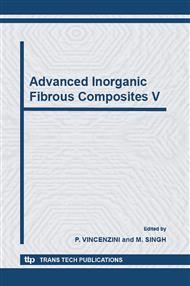p.107
p.115
p.124
p.130
p.141
p.147
p.153
p.163
p.174
Static Fatigue of a 2.5D SiC/[Si-B-C] Composite at Intermediate Temperature under Air
Abstract:
Non-oxide ceramic-matrix composites (CMCs) are subjected to be used in aeronautic applications which require very long duration (up to 100 000h) of materials at high temperatures and under air. Recently a self-healing [Si-B-C] matrix has been developped to enhance strongly the lifetime of CMCs under air. The aim of this work is to study the mechanical behaviour of a SiCf/[Si-B-C] composite with a self-healing matrix under static fatigue, and to determine its lifetime. During the mechanical tests, acoustic emission is detected in order to characterize the damage of the composite in addition to the measurement of the longitudinal deformation of the composite. The analysis of acoustic emission follows a non-supervised procedure of classification. Each event of acoustic emission is described by a set of several parameters, and the total activity can be divided in four classes. The assignment of each class to a damage mechanism is required to follow the spread of damage during fatigue and to determine the mechanisms controlling the failure of the composite.
Info:
Periodical:
Pages:
141-146
Citation:
Online since:
October 2006
Authors:
Price:
Сopyright:
© 2006 Trans Tech Publications Ltd. All Rights Reserved
Share:
Citation:


